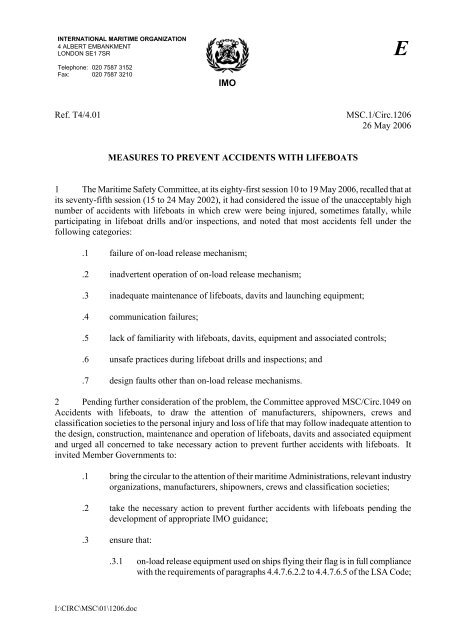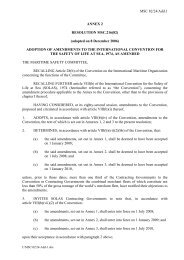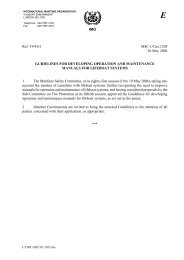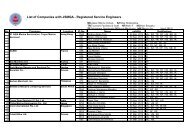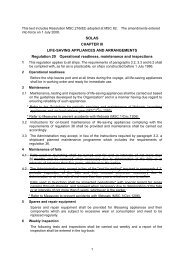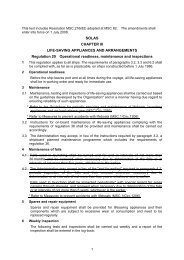measures to prevent accidents with lifeboats - IMO
measures to prevent accidents with lifeboats - IMO
measures to prevent accidents with lifeboats - IMO
Create successful ePaper yourself
Turn your PDF publications into a flip-book with our unique Google optimized e-Paper software.
INTERNATIONAL MARITIME ORGANIZATION<br />
4 ALBERT EMBANKMENT<br />
LONDON SE1 7SR<br />
Telephone: 020 7587 3152<br />
Fax: 020 7587 3210<br />
<strong>IMO</strong><br />
E<br />
Ref. T4/4.01<br />
MSC.1/Circ.1206<br />
26 May 2006<br />
MEASURES TO PREVENT ACCIDENTS WITH LIFEBOATS<br />
1 The Maritime Safety Committee, at its eighty-first session 10 <strong>to</strong> 19 May 2006, recalled that at<br />
its seventy-fifth session (15 <strong>to</strong> 24 May 2002), it had considered the issue of the unacceptably high<br />
number of <strong>accidents</strong> <strong>with</strong> <strong>lifeboats</strong> in which crew were being injured, sometimes fatally, while<br />
participating in lifeboat drills and/or inspections, and noted that most <strong>accidents</strong> fell under the<br />
following categories:<br />
.1 failure of on-load release mechanism;<br />
.2 inadvertent operation of on-load release mechanism;<br />
.3 inadequate maintenance of <strong>lifeboats</strong>, davits and launching equipment;<br />
.4 communication failures;<br />
.5 lack of familiarity <strong>with</strong> <strong>lifeboats</strong>, davits, equipment and associated controls;<br />
.6 unsafe practices during lifeboat drills and inspections; and<br />
.7 design faults other than on-load release mechanisms.<br />
2 Pending further consideration of the problem, the Committee approved MSC/Circ.1049 on<br />
Accidents <strong>with</strong> <strong>lifeboats</strong>, <strong>to</strong> draw the attention of manufacturers, shipowners, crews and<br />
classification societies <strong>to</strong> the personal injury and loss of life that may follow inadequate attention <strong>to</strong><br />
the design, construction, maintenance and operation of <strong>lifeboats</strong>, davits and associated equipment<br />
and urged all concerned <strong>to</strong> take necessary action <strong>to</strong> <strong>prevent</strong> further <strong>accidents</strong> <strong>with</strong> <strong>lifeboats</strong>. It<br />
invited Member Governments <strong>to</strong>:<br />
.1 bring the circular <strong>to</strong> the attention of their maritime Administrations, relevant industry<br />
organizations, manufacturers, shipowners, crews and classification societies;<br />
.2 take the necessary action <strong>to</strong> <strong>prevent</strong> further <strong>accidents</strong> <strong>with</strong> <strong>lifeboats</strong> pending the<br />
development of appropriate <strong>IMO</strong> guidance;<br />
.3 ensure that:<br />
.3.1 on-load release equipment used on ships flying their flag is in full compliance<br />
<strong>with</strong> the requirements of paragraphs 4.4.7.6.2.2 <strong>to</strong> 4.4.7.6.5 of the LSA Code;<br />
I:\CIRC\MSC\01\1206.doc
MSC.1/Circ.1206 - 2 -<br />
I:\CIRC\MSC\01\1206.doc<br />
.3.2 all appropriate documentation for the maintenance and adjustment of<br />
<strong>lifeboats</strong>, launching appliances and associated equipment is available<br />
on board;<br />
.3.3 personnel undertaking inspections, maintenance and adjustment of <strong>lifeboats</strong>,<br />
launching appliances and associated equipment are fully trained and familiar<br />
<strong>with</strong> these duties;<br />
.3.4 maintenance of <strong>lifeboats</strong>, launching appliances and associated equipment is<br />
carried out in accordance <strong>with</strong> approved established procedures;<br />
.3.5 lifeboat drills are conducted in accordance <strong>with</strong> SOLAS regulation III/19.3.3<br />
for the purpose of ensuring that ship’s personnel will be able <strong>to</strong> safely embark<br />
and launch the <strong>lifeboats</strong> in an emergency;<br />
.3.6 the principles of safety and health at work apply <strong>to</strong> drills as well;<br />
.3.7 personnel undertaking maintenance and repair activities are appropriately<br />
qualified;<br />
.3.8 hanging-off pennants should only be used for maintenance purposes and not<br />
during training exercises;<br />
.3.9 all tests required for the design and approval of life-saving appliances are<br />
conducted rigorously, according <strong>to</strong> the guidelines developed by the<br />
Organization, in order <strong>to</strong> identify and rectify any design faults at an early<br />
stage;<br />
.3.10 the equipment is easily accessible for inspections and maintenance and is<br />
proven durable in harsh operational conditions, in addition <strong>to</strong> <strong>with</strong>standing<br />
pro<strong>to</strong>type tests; and<br />
.3.11 the approving authorities or bodies pay close attention <strong>to</strong> proper<br />
workmanship and state-of-the-art possibilities when assessing equipment for<br />
approval; and<br />
.4 encourage shipowners, when undertaking maintenance and repair activities, <strong>to</strong><br />
employ qualified personnel, preferably certified by the manufacturer.<br />
3 Member Governments were further invited, while enforcing the provisions of SOLAS<br />
regulation IX/4.3, <strong>to</strong> ensure that the above issues are addressed through the Safety Management<br />
System of the company, as appropriate.<br />
4 The Committee further recalled that, at its seventy-seventh session (28 May <strong>to</strong> 6 June 2003),<br />
recognizing the experience gained since the approval of the Guidelines on inspection<br />
and maintenance of lifeboat on-load release gear (MSC/Circ.614) at its sixty-second session<br />
(24 <strong>to</strong> 28 May 1993), and that the implementation of expanded and improved guidelines could<br />
contribute <strong>to</strong>wards a reduction of the incidence of <strong>accidents</strong> <strong>with</strong> <strong>lifeboats</strong>, it had approved the<br />
Guidelines for periodic servicing and maintenance of <strong>lifeboats</strong>, launching appliances and on-load<br />
release gear (MSC/Circ.1093), superseding MSC/Circ.614. Taking in<strong>to</strong> account subsequent<br />
amendments <strong>to</strong> SOLAS chapter III and the LSA Code, and having considered proposals by the<br />
fiftieth session of the Sub-Committee on Fire Protection, the Committee approved amendments <strong>to</strong>
- 3 - MSC.1/Circ.1206<br />
the Guidelines as set out in annex 1. The Committee further noted that the guidance developed for<br />
<strong>lifeboats</strong> could also apply <strong>to</strong> the periodic servicing and maintenance of liferafts, rescue boats and fast<br />
rescue boats and their launching appliances and on-load release gear.<br />
5 The Committee further recalled that, at its seventy-ninth session (1 <strong>to</strong> 10 December 2004), it<br />
had endorsed the intention of the Sub-Committee on Ship Design and Equipment, in co-operation<br />
<strong>with</strong> the Sub-Committee on Standards of Training and Watchkeeping, <strong>to</strong> develop further <strong>IMO</strong><br />
guidance as envisioned in MSC/Circ.1049, and accordingly, approved the Guidance on safety during<br />
abandon ship drills using <strong>lifeboats</strong> (MSC/Circ.1136), as set out in annex 2. The Committee further<br />
recalled that the Guidance developed for <strong>lifeboats</strong> has relevance, in general, for emergency drills<br />
<strong>with</strong> other life-saving systems and should be taken in<strong>to</strong> account when such drills are conducted. In<br />
connection <strong>with</strong> MSC/Circ.1136, and recognizing the need <strong>to</strong> provide a basic outline of essential<br />
steps <strong>to</strong> safely carry out simulated launching of free-fall <strong>lifeboats</strong> in accordance <strong>with</strong><br />
SOLAS regulation III/19.3.3.4, and having considered proposals by the forty-seventh session of the<br />
Sub-Committee on Design and Equipment, the Committee further approved the Guidelines for<br />
simulated launching of free-fall <strong>lifeboats</strong> (MSC/Circ.1137), as set out in the appendix <strong>to</strong> annex 2.<br />
6 Having considered the need <strong>to</strong> update several of the circulars discussed above, and having<br />
considered proposals by the fiftieth session of the Sub-Committee on Fire Protection <strong>to</strong> consolidate<br />
the numerous circulars on the subject of <strong>measures</strong> <strong>to</strong> <strong>prevent</strong> <strong>accidents</strong> <strong>with</strong> <strong>lifeboats</strong> in order <strong>to</strong><br />
better serve the mariner, the Committee approved the annexed Guidelines for periodic servicing and<br />
maintenance of <strong>lifeboats</strong>, launching appliances and on-load release gear (annex 1) and Guidelines on<br />
safety during abandon ship drills using <strong>lifeboats</strong> (annex 2).<br />
7 Member Governments are invited <strong>to</strong> give effect <strong>to</strong> the annexed Guidelines as soon as possible<br />
and <strong>to</strong> bring them <strong>to</strong> the attention of shipowners, ship opera<strong>to</strong>rs, ship-vetting organizations, ship<br />
personnel, surveyors, manufacturers and all others concerned <strong>with</strong> the inspection and maintenance of<br />
<strong>lifeboats</strong>, liferafts, rescue boats and fast rescue boats and their launching appliances and on-load<br />
release gear.<br />
8 This circular supersedes MSC/Circ.1049, MSC/Circ.1093, MSC/Circ.1136 and MSC/Circ.1137.<br />
***<br />
I:\CIRC\MSC\01\1206.doc
MSC.1/Circ.1206<br />
ANNEX 1<br />
GUIDELINES FOR PERIODIC SERVICING AND MAINTENANCE OF LIFEBOATS,<br />
LAUNCHING APPLIANCES AND ON-LOAD RELEASE GEAR<br />
General<br />
1 The objective of these Guidelines is <strong>to</strong> establish a uniform, safe and documented performance<br />
of periodic servicing and maintenance of <strong>lifeboats</strong>, launching appliances and on-load release gear.<br />
2 These Guidelines relate <strong>to</strong> the application of the ISM Code <strong>to</strong> periodic servicing and<br />
maintenance of lifeboat arrangements and should therefore be reflected in procedures developed for<br />
a ship under that Code.<br />
3 The general principle in these Guidelines may also be applied for the periodic servicing and<br />
maintenance of liferafts, rescue boats and fast rescue boats and their launching appliances and<br />
release gear.<br />
4 Detailed guidance regarding some procedures covered by these Guidelines is provided in the<br />
appendix.<br />
SOLAS regulations<br />
5 These Guidelines relate <strong>to</strong> the requirements contained in:<br />
.1 SOLAS regulation III/20 – Operational readiness, maintenance and inspections; and<br />
.2 SOLAS regulation III/36 – Instructions for on-board maintenance.<br />
Responsibility<br />
6 The company * is responsible for servicing and maintenance onboard its ships in accordance<br />
<strong>with</strong> SOLAS regulation III/20 and for the establishment and implementation of health, safety and<br />
environment (HSE) procedures covering all activities during servicing and maintenance.<br />
7 The personnel carrying out servicing and maintenance are responsible for the performance of<br />
the work as authorized in accordance <strong>with</strong> the system specified in paragraph 10.<br />
8 The above personnel are also responsible for complying <strong>with</strong> HSE instructions and<br />
procedures.<br />
9 Where satisfied <strong>with</strong> an organization’s ability <strong>to</strong> carry out these functions, the Administration<br />
may authorize such organization and its personnel <strong>to</strong> perform the functions of the manufacturer and<br />
manufacturer’s certified personnel as assigned under these Guidelines, if manufacturer certified<br />
facilities are not available.<br />
*<br />
For the purpose of these Guidelines, company is as defined in SOLAS regulation IX/1.2.<br />
I:\CIRC\MSC\01\1206.doc
MSC.1/Circ.1206<br />
ANNEX 1<br />
Page 2<br />
Authorization<br />
10 Where these Guidelines require certification of servicing personnel, such certification should<br />
be issued by the manufacturer in accordance <strong>with</strong> an established system for training and<br />
authorization.<br />
Qualification levels<br />
11 Weekly and monthly inspections, and routine maintenance as defined by the manufacturer,<br />
should be conducted under the direct supervision of a senior ship’s officer in accordance <strong>with</strong> the<br />
instructions provided by the manufacturer.<br />
12 All other inspections, servicing and repair should be conducted by the manufacturer’s<br />
representative or a person appropriately trained and certified by the manufacturer for the work <strong>to</strong><br />
be done.<br />
Reports and records<br />
13 All reports and checklists should be correctly filled out and signed by the person who carries<br />
out the inspection and maintenance work and should also be signed by the company’s representative<br />
or the ship’s master.<br />
14 Records of inspections, servicing, repairs and maintenance should be updated and filed<br />
onboard the ship.<br />
15 When repairs, thorough servicing and annual servicing are completed, a statement confirming<br />
that the lifeboat arrangements remain fit for purpose should be issued by the manufacturer’s<br />
representative or by the person certified by the manufacturer for the work.<br />
* * *<br />
I:\CIRC\MSC\01\1206.doc
MSC.1/Circ.1206<br />
ANNEX 1<br />
Page 3<br />
APPENDIX<br />
SPECIFIC PROCEDURES FOR MAINTENANCE AND SERVICING<br />
1 GENERAL<br />
1.1 Any inspection, servicing and repair should be carried out according <strong>to</strong> the system for<br />
inspection and services developed by the manufacturer.<br />
1.2 A full set of maintenance manuals and associated documentation issued by the manufacturer<br />
should be available on board for use in all operations involved in the inspection, maintenance,<br />
adjustment and re-setting of the lifeboat and associated equipment, such as davits and release gear.<br />
1.3 The manufacturer’s system for inspection and services should include the following items as<br />
a minimum.<br />
2 ANNUAL THOROUGH EXAMINATION<br />
2.1 As items listed in checklists for the weekly/monthly inspections also form the first part of the<br />
annual thorough examination, when carrying out this examination the inspection of these items<br />
should be performed by the ship’s crew in the presence of the manufacturer’s representative or a<br />
person appropriately trained and certified by the manufacturer for the work <strong>to</strong> be done.<br />
2.2 Inspection and maintenance records of inspections and routine maintenance carried out by the<br />
ship’s crew and the applicable certificates for the launching appliances and equipment should be<br />
available.<br />
2.3 Repairs and replacement of parts should be carried out in accordance <strong>with</strong> the manufacturer’s<br />
requirements and standards.<br />
Lifeboats<br />
2.4 The following items should be examined and checked for satisfac<strong>to</strong>ry condition and<br />
operation:<br />
.1 condition of lifeboat structure including fixed and loose equipment;<br />
.2 engine and propulsion system;<br />
.3 sprinkler system, where fitted;<br />
.4 air supply system, where fitted;<br />
.5 manoeuvring system;<br />
.6 power supply system; and<br />
.7 bailing system.<br />
I:\CIRC\MSC\01\1206.doc
MSC.1/Circ.1206<br />
ANNEX 1<br />
Page 4<br />
Release gear<br />
2.5 The following should be examined for satisfac<strong>to</strong>ry condition and operation after the annual<br />
winch brake test <strong>with</strong> the empty boat, as required by paragraph 3.1:<br />
.1 operation of devices for activation of release gear;<br />
.2 excessive free play (<strong>to</strong>lerances);<br />
.3 hydrostatic interlock system, where fitted;<br />
.4 cables for control and release; and<br />
.5 hook fastening.<br />
Notes:<br />
1 The setting and maintenance of release gear are critical operations <strong>with</strong> regard <strong>to</strong><br />
maintaining the safe operation of the lifeboat and the safety of personnel in the<br />
lifeboat. All inspection and maintenance operations on this equipment should<br />
therefore be carried out <strong>with</strong> the utmost care.<br />
2 No maintenance or adjustment of the release gear should be undertaken while the<br />
hooks are under load.<br />
3 Hanging-off pennants may be used for this purpose but should not remain connected<br />
at other times, such as when the lifeboat is normally s<strong>to</strong>wed and during training<br />
exercises.<br />
4 The release gear is <strong>to</strong> be examined prior <strong>to</strong> its operational test. The release gear is <strong>to</strong><br />
be re-examined after its operational test and the dynamic winch brake test. Special<br />
consideration should be given <strong>to</strong> ensure that no damage has occurred during the<br />
winch brake test, especially the hook fastening.<br />
2.6 Operational test of on-load release function:<br />
.1 position the lifeboat partially in<strong>to</strong> the water such that the mass of the boat is<br />
substantially supported by the falls and the hydrostatic interlock system, where fitted,<br />
is not triggered;<br />
.2 operate the on-load release gear;<br />
.3 reset the on-load release gear; and<br />
.4 examine the release gear and hook fastening <strong>to</strong> ensure that the hook is completely<br />
reset and no damage has occurred.<br />
I:\CIRC\MSC\01\1206.doc
MSC.1/Circ.1206<br />
ANNEX 1<br />
Page 5<br />
2.7 Operational test of off-load release function:<br />
.1 position the lifeboat fully waterborne;<br />
.2 operate the off-load release gear;<br />
.3 reset the on-load release gear; and<br />
.4 recover the lifeboat <strong>to</strong> the s<strong>to</strong>wed position and prepare for operational readiness.<br />
Note:<br />
Prior <strong>to</strong> hoisting, check that the release gear is completely and properly reset. The final<br />
turning-in of the lifeboat should be done <strong>with</strong>out any persons on board.<br />
2.8 Operational test of free-fall lifeboat release function:<br />
Davit<br />
.1 engage the simulated launching arrangements as specified in the manufacturer’s<br />
operating instructions;<br />
.2 the opera<strong>to</strong>r should be properly seated and secured in the seat location from which<br />
the release mechanism is <strong>to</strong> be operated;<br />
.3 operate the release mechanism <strong>to</strong> release the lifeboat;<br />
.4 reset the lifeboat in the s<strong>to</strong>wed configuration;<br />
.5 repeat procedures .2 <strong>to</strong> .4 above, using the back-up release mechanism, when<br />
applicable.<br />
.6 remove the simulated launching arrangements; and<br />
.7 verify that the lifeboat is in the ready <strong>to</strong> launch s<strong>to</strong>wed configuration.<br />
2.9 The following items should be examined for satisfac<strong>to</strong>ry condition and operation:<br />
.1 davit structure, in particular <strong>with</strong> regard <strong>to</strong> corrosion, misalignments, deformations<br />
and excessive free play;<br />
.2 wires and sheaves, possible damages such as kinks and corrosion;<br />
.3 lubrication of wires, sheaves and moving parts;<br />
.4 functioning of limit switches;<br />
.5 s<strong>to</strong>red power systems; and<br />
.6 hydraulic systems.<br />
I:\CIRC\MSC\01\1206.doc
MSC.1/Circ.1206<br />
ANNEX 1<br />
Page 6<br />
Winch<br />
2.10 The following items should be examined for satisfac<strong>to</strong>ry condition and operation:<br />
.1 open and inspect brake mechanism;<br />
.2 replace brake pads, if necessary;<br />
.3 remote control system;<br />
.4 power supply system; and<br />
.5 winch foundation.<br />
3 DYNAMIC WINCH BRAKE TEST<br />
3.1 Annual operational testing should preferably be done by lowering the empty boat. When the<br />
boat has reached its maximum lowering speed and before the boat enters the water, the brake should<br />
be abruptly applied.<br />
3.2 The five-year operational test should be done by lowering the boat loaded <strong>to</strong> a proof load<br />
equal <strong>to</strong> 1.1 times the weight of the survival craft or rescue boat and its full complement of persons<br />
and equipment, or equivalent load. When the boat has reached its maximum lowering speed and<br />
before the boat enters the water, the brake should be abruptly applied.<br />
3.3 Following these tests, the brake pads and stressed structural parts should be re-inspected.<br />
Note:<br />
In loading the boat for this test, precautions should be taken <strong>to</strong> ensure that the stability of the<br />
boat is not adversely affected by free surface effects or the raising of the centre of gravity.<br />
4 OVERHAUL OF ON-LOAD RELEASE GEAR<br />
Overhaul of on-load release gear includes:<br />
.1 dismantling of hook release units;<br />
.2 examination <strong>with</strong> regard <strong>to</strong> <strong>to</strong>lerances and design requirements;<br />
.3 adjustment of release gear system after assembly;<br />
.4 operational test as per above and <strong>with</strong> a load according <strong>to</strong> SOLAS regulation III/20.11.2.3;<br />
and<br />
.5 examination of vital parts <strong>with</strong> regard <strong>to</strong> defects and cracks.<br />
Note:<br />
Non-destructive examination (NDE) techniques, such as dye penetrants (DPE), may be suitable.<br />
I:\CIRC\MSC\01\1206.doc<br />
***
MSC.1/Circ.1206<br />
ANNEX 2<br />
GUIDELINES ON SAFETY DURING ABANDON SHIP DRILLS USING LIFEBOATS<br />
1 GENERAL<br />
1.1 Introduction<br />
1.1.1 It is essential that seafarers are familiar <strong>with</strong> the life-saving systems on board their ships and<br />
that they have confidence that the systems provided for their safety will work and will be effective in<br />
an emergency. Frequent periodic shipboard drills are necessary <strong>to</strong> achieve this.<br />
1.1.2 Crew training is an important component of drills. As a supplement <strong>to</strong> initial shore-side<br />
training, on board training will familiarize crew members <strong>with</strong> the ship systems and the associated<br />
procedures for use, operation and drills. On these occasions, the objective is <strong>to</strong> develop appropriate<br />
crew competencies, enabling effective and safe utilization of the equipment required by the 1974<br />
SOLAS Convention. The time limits set out in SOLAS for ship abandonment should be considered<br />
as a secondary objective when conducting drills.<br />
1.2 Drill frequency<br />
Experience has shown that holding frequent drills furthers the goals of making the crew familiar <strong>with</strong><br />
the life-saving systems on board their ships and increasing their confidence that the systems will<br />
work and will be effective in an emergency. Drills give the crew opportunity <strong>to</strong> gain experience in<br />
the use of the safety equipment and in co-operation. The ability <strong>to</strong> cope <strong>with</strong> an emergency and<br />
handle the situation, if the ship needs <strong>to</strong> be abandoned, needs <strong>to</strong> be well rehearsed. However,<br />
frequent crew changes sometimes make it difficult <strong>to</strong> assure that all on board have had the<br />
opportunity <strong>to</strong> participate in drills if only the minimum required drills are conducted. Therefore,<br />
consideration needs <strong>to</strong> be given <strong>to</strong> scheduling drills as necessary <strong>to</strong> ensure all on board have an early<br />
opportunity <strong>to</strong> become familiar <strong>with</strong> the systems on board.<br />
1.3 Drills must be safe<br />
1.3.1 Abandon ship drills should be planned, organized and performed so that the recognized risks<br />
are minimized and in accordance <strong>with</strong> relevant shipboard requirements of occupational safety and<br />
health.<br />
1.3.2 Drills provide an opportunity <strong>to</strong> verify that the life-saving system is working and that all<br />
associated equipment is in place and in good working order, ready for use.<br />
1.3.3 Before conducting drills, it should be checked that the lifeboat and its safety equipment have<br />
been maintained in accordance <strong>with</strong> the manufacturer’s instructions, as well as noting all the<br />
precautionary <strong>measures</strong> necessary. Abnormal conditions of wear and tear or corrosion should be<br />
reported <strong>to</strong> the responsible officer immediately.<br />
1.4 Emphasis on learning<br />
Drills should be conducted <strong>with</strong> an emphasis on learning and be viewed as a learning experience, not<br />
just as a task <strong>to</strong> meet a regula<strong>to</strong>ry requirement <strong>to</strong> conduct drills. Whether they are emergency drills<br />
I:\CIRC\MSC\01\1206.doc
MSC.1/Circ.1206<br />
ANNEX 2<br />
Page 2<br />
required by SOLAS or additional special drills conducted <strong>to</strong> enhance the competence of the crew<br />
members, they should be carried out at safe speed. During drills, care should be taken <strong>to</strong> ensure that<br />
everybody familiarizes themselves <strong>with</strong> their duties and <strong>with</strong> the equipment.<br />
If necessary, pauses should be made during the drills <strong>to</strong> explain especially difficult elements. The<br />
experience of the crew is an important fac<strong>to</strong>r in determining how fast a drill or certain drill elements<br />
should be carried out.<br />
1.5 Planning and organizing drills<br />
1.5.1 The 1974 SOLAS Convention requires that drills shall, as far as practicable, be conducted as<br />
if there was an actual emergency. * This means that the entire drill should, as far as possible, be<br />
carried out. The point is that, at the same time, it should be ensured that the drill can be carried out<br />
in such a way that it is safe in every respect. Consequently, elements of the drill that may involve<br />
unnecessary risks need special attention or may be excluded from the drill.<br />
1.5.2 In preparing for a drill, those responsible should review the manufacturer’s instruction<br />
manual <strong>to</strong> assure that a planned drill is conducted properly. Those responsible for the drill should<br />
assure that the crew is familiar <strong>with</strong> the guidance provided in the life-saving system<br />
instruction manual.<br />
1.5.3 Lessons learned in the course of a drill should be documented and made a part of follow-up<br />
shipboard training discussions and planning the next drill session.<br />
1.5.4 The lowering of a boat <strong>with</strong> its full complement of persons is an example of an element of a<br />
drill that may, depending on the circumstances, involve an unnecessary risk. Such drills should only<br />
be carried out if special precautions are observed.<br />
2 ABANDON SHIP DRILLS<br />
2.1 Introduction<br />
It is important that the crew who operate safety equipment on board are familiar <strong>with</strong> the functioning<br />
and operation of such equipment. The 1974 SOLAS Convention requires that sufficiently detailed<br />
manufacturers’ training manuals and instructions be carried on board, which should be easily<br />
unders<strong>to</strong>od by the crew. Such manufacturers’ manuals and instructions should be accessible for<br />
everyone on board and observed and followed closely during drills.<br />
2.2 Guidance <strong>to</strong> the shipowner<br />
2.2.1 The shipowner should ensure that new safety equipment on board the company’s ships has<br />
been approved and installed in accordance <strong>with</strong> the provisions of the 1974 SOLAS Convention and<br />
the International Life-Saving Appliances (LSA) Code.<br />
2.2.2 Procedures for holding safe drills should be included in the Safety Management System<br />
(SMS) of the shipping companies. Detailed procedures for elements of drills that involve a special<br />
risk should be evident from workplace assessments adjusted <strong>to</strong> the relevant life-saving appliance.<br />
*<br />
Refer <strong>to</strong> SOLAS regulation III/19.3.1.<br />
I:\CIRC\MSC\01\1206.doc
MSC.1/Circ.1206<br />
ANNEX 2<br />
Page 3<br />
2.2.3 Personnel carrying out maintenance and repair work on <strong>lifeboats</strong> should be qualified<br />
accordingly. *<br />
2.3 Lifeboats lowered by means of falls<br />
2.3.1 During drills, those responsible should be alert for potentially dangerous conditions and<br />
situations and should bring them <strong>to</strong> the attention of the responsible person for appropriate action.<br />
Feedback and improvement recommendations <strong>to</strong> the shipowner, the Administration and the system<br />
manufacturer are important elements of the marine safety system.<br />
2.3.2 Before placing persons onboard a lifeboat, it is recommended that the boat first be lowered<br />
and recovered <strong>with</strong>out persons on board <strong>to</strong> ascertain that the arrangement functions correctly. The<br />
boat should then be lowered in<strong>to</strong> the water <strong>with</strong> only the number of persons on board necessary <strong>to</strong><br />
operate the boat.<br />
2.3.3 To <strong>prevent</strong> lashings or gripes from getting entangled, proper release should be checked<br />
before swinging out the davit.<br />
2.4 Free-fall <strong>lifeboats</strong><br />
2.4.1 The monthly drills <strong>with</strong> free-fall <strong>lifeboats</strong> should be carried out according <strong>to</strong> the<br />
manufacturer’s instructions, so that the persons who are <strong>to</strong> enter the boat in an emergency are trained<br />
<strong>to</strong> embark the boat, <strong>to</strong> take their seats in a correct way and <strong>to</strong> use the safety belts; and also are<br />
instructed on how <strong>to</strong> act during launching in<strong>to</strong> the sea.<br />
2.4.2 When the lifeboat is free-fall launched as part of a drill, this should be carried out <strong>with</strong> the<br />
minimum personnel required <strong>to</strong> manoeuvre the boat in the water and <strong>to</strong> recover it. The recovery<br />
operation should be carried out <strong>with</strong> special attention, bearing in mind the high risk level of this<br />
operation. Where permitted by SOLAS, simulated launching should be carried out in accordance<br />
<strong>with</strong> the manufacturer’s instructions, taking due note of the Guidelines for simulated launching of<br />
free-fall <strong>lifeboats</strong> at appendix.<br />
* * *<br />
*<br />
Refer <strong>to</strong> the Guidelines for periodic servicing and maintenance of <strong>lifeboats</strong>, launching appliances and on-load release<br />
gear (see annex 1).<br />
I:\CIRC\MSC\01\1206.doc
MSC.1/Circ.1206<br />
ANNEX 2<br />
Page 4<br />
APPENDIX<br />
GUIDELINES FOR SIMULATED LAUNCHING OF FREE-FALL LIFEBOATS<br />
1 Definition<br />
Simulated launching is a means of training the crew in the free-fall release procedure of free-fall<br />
<strong>lifeboats</strong> and in verifying the satisfac<strong>to</strong>ry function of the free-fall release system <strong>with</strong>out allowing<br />
the lifeboat <strong>to</strong> fall in<strong>to</strong> the sea.<br />
2 Purpose and scope<br />
The purpose of these Guidelines is <strong>to</strong> provide a basic outline of essential steps <strong>to</strong> safely carry out<br />
simulated launching. These Guidelines are general; the lifeboat manufacturer’s instruction manual<br />
should always be consulted before conducting simulated launching. Simulated launching should<br />
only be carried out <strong>with</strong> <strong>lifeboats</strong> and launching appliances designed <strong>to</strong> accommodate it, and for<br />
which the manufacturer has provided instructions. Simulated launching should be carried out under<br />
the supervision of a responsible person who should be an officer experienced in such procedures.<br />
3 Typical simulated launching sequence<br />
3.1 Check equipment and documentation <strong>to</strong> ensure that all components of the lifeboat and<br />
launching appliance are in good operational condition.<br />
3.2 Ensure that the restraining device(s) provided by the manufacturer for simulated launching<br />
are installed and secure and that the free-fall release mechanism is fully and correctly engaged.<br />
3.3 Establish and maintain good communication between the assigned operating crew and the<br />
responsible person.<br />
3.4 Disengage lashings, gripes, etc. installed <strong>to</strong> secure the lifeboat for sea or for maintenance,<br />
except those required for simulated free-fall.<br />
3.5 Participating crew board the lifeboat and fasten their seatbelts under the supervision of the<br />
responsible person.<br />
3.6 All crew, except the assigned operating crew, disembark the lifeboat. The assigned operating<br />
crew fully prepares the lifeboat for free-fall launch and secures themselves in their seats for the<br />
release operation.<br />
3.7 The assigned operating crew activates the release mechanism when instructed by the<br />
responsible person. Ensure that the release mechanism operates satisfac<strong>to</strong>rily and, if applicable, the<br />
lifeboat travels down the ramp <strong>to</strong> the distance specified in the manufacturer’s instructions.<br />
3.8 Resecure the lifeboat <strong>to</strong> its s<strong>to</strong>wed position, using the means provided by the manufacturer<br />
and ensure that the free-fall release mechanism is fully and correctly engaged.<br />
3.9 Repeat procedures from 3.7 above, using the back-up release mechanism when applicable.<br />
I:\CIRC\MSC\01\1206.doc
MSC.1/Circ.1206<br />
ANNEX 2<br />
Page 5<br />
3.10 The assigned operating crew disembarks the lifeboat.<br />
3.11 Ensure that the lifeboat is returned <strong>to</strong> its normal s<strong>to</strong>wed condition. Remove any restraining<br />
and/or recovery devices used only for the simulated launch procedure.<br />
_____________<br />
I:\CIRC\MSC\01\1206.doc


